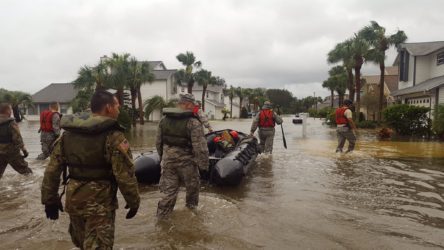
Climate & Energy Resiliency in the FY2021 NDAA
On January 1, the FY2021 National Defense Authorization Act (NDAA) became law after the U.S. Senate voted to override former President Donald Trump’s veto of the annual defense policy legislative package (H.R. 6395). The U.S. House had voted to override Trump’s veto on December 28, 2020.
ASP published an article on the NDAA climate and energy provisions in July last year. However, the text that became law included a few important additions. Below are the final key climate and energy security provisions.
A NEW ROADMAP TO ADDRESS THE EFFECTS OF CLIMATE CHANGE
Sec. 327 requires the Secretary of Defense to update the 2014 DoD Climate Adaptation Roadmap by February 2022. The report should outline the DoD’s comprehensive strategy for addressing the effects of climate change—worsening storms, drought, flooding, wildfires, and melting sea ice. Unlike previous DoD Climate Roadmaps, the updated version must provide top-line estimates of the investments required to address costs incurred by climate change over the next five, ten, and 20 years. These investments may address heightened demand for disaster or humanitarian relief operations, climate threats to testing and training and military installations, and increased operations in an increasingly ice-free Arctic.
—
REPORT ON THE EFFECTS OF CLIMATE CHANGE ON THE COAST GUARD
Sec. 8250 calls for the Commandant of the Coast Guard to report on the vulnerabilities of Coast Guard installations and requirements resulting from climate change over the next 20 years. The report must be submitted to the relevant House and Senate Committees no later than January 2022 and should list the 10 Coast Guard installations most vulnerable to climate change and describe the effects of climate change on the Coast Guard as a whole. Finally, the report should provide an overview of necessary mitigation steps and the cost associated.
—
NEW NATIONAL ACADEMIES CLIMATE SECURITY ROUNDTABLE
Sec. 1622 calls for the creation of a new National Academies Climate Security Roundtable to facilitate dialogue and collaboration with respect to climate security among stakeholders from the federal government, the intelligence community, and non-federal research institutions.
—
ASSISTANT SECRETARY OF DEFENSE FOR ENERGY, INSTALLATIONS, AND ENVIRONMENT
Sec. 904 reestablishes the position of Assistant Secretary of Defense for Energy, Installations, and Environment. The Assistant Secretary will be responsible for managing energy and climate initiatives within the DoD, such as the Operational Energy Capability Improvement Fund of the Department of Defense
—
REPORT ON DoD GREENHOUSE GAS EMISSIONS LEVELS
Sec. 328 requires the Secretary of Defense to submit to Congress a report on the total level of greenhouse gas (GHG) emissions for each of the last 10 fiscal years.
The U.S. military is one of the largest climate polluters in the world, and DoD is the largest energy consumer within the federal government – though the DoD’s share of federal government energy usage has fallen in recent years. Recording data on GHG emissions is an important step to identify ways to reduce the energy intensity of DoD operations. Several energy resilience provisions, detailed below, go further in requiring the DoD to measure energy consumption and pursue renewable energy sources for military installations.
—
MILITARY INSTALLATION AND ENERGY RESILIENCE PROVISIONS
Sec. 2825 amends existing DoD energy policy by requiring the Secretary of Defense to carry out at least four projects to promote installation energy security and energy resilience, including use of renewable energy sources.
—
Sec. 2826 calls on the Secretary of Defense and the Secretaries of the military departments to improve electrical metering to accurately determine energy consumption by DoD infrastructure supporting critical missions.
—
Sec. 315 expands the DoD’s authority to carry out military installation resilience projects outside of a military installation or facilities, provided that the Secretary of Defense considers that the project would preserve or enhance the resilience of a military installation, facility, or other mission-critical function.
This provision is important because it strengthens DoD’s ability to ensure the climate resiliency of military installations and facilities, many of which depend on community infrastructure vulnerable to climate change and extreme weather, such as bridges, electricity, water, and medical facilities.
—
Sec. 316 amends existing DoD energy policy by requiring the Secretary of Defense to ensure 99.9% availability levels (per fiscal year) for the energy loads of missions critical to each military installation.
—
Sec. 2804 amends existing DoD energy policy by requiring the Secretary of Defense to incorporate the long-term consideration of energy security and resilience into evaluations of military construction life-cycle costs.
—
ASP strongly believes that climate security is national security and has written extensively on the impacts of climate change on U.S. military bases, with a website dedicated solely to issues of military base resilience. However, ASP’s work doesn’t stop at the first-order national security impacts of climate change. ASP also examines the broader implications of climate change for U.S. national security interests. Recent publications in this vein include: adopting sustainable farming methods, putting gender and climate on the regional agenda, building Caribbean resilience with fossil fuel revenues, and examining the role climate change is playing in great power rivalry.





